by Robert Lopez and Jeff Hawk
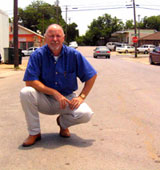 City of Stephenville officials have at least a dozen reasons to endorse using cement to rehabilitate their streets. None of Stephenville’s cement-recycled streets have had problems or failed in the past 12 years. “They’ve not done any re-work on any of the bases that we’ve [cement] stabilized,” said Sanford LaHue, Jr., consulting engineer, Schrickel, Rollins and Associates, Arlington.
City of Stephenville officials have at least a dozen reasons to endorse using cement to rehabilitate their streets. None of Stephenville’s cement-recycled streets have had problems or failed in the past 12 years. “They’ve not done any re-work on any of the bases that we’ve [cement] stabilized,” said Sanford LaHue, Jr., consulting engineer, Schrickel, Rollins and Associates, Arlington.
Consulting engineer Sanford LaHue, Jr. stands on a cement-recycled street he designed in 1992. The street has experienced no base failure since then.
LaHue designed the city’s first cement-recycled streets in 1992 and has continued consulting for the city since then. The street reconstruction program initially included visual evaluations of the condition of the streets to determine which streets would require cement recycling. The recycling and a new asphalt surface course was proposed where base failures had occurred. A standard asphalt overlay was placed where minor cracking was observed. This evaluation and selection procedure allowed the city to do as many streets as possible. But over the years, LaHue observed serious deterioration in the overlain streets while the cement recycled streets held firm. He began to specify cement recycling for all of the streets. “From 2000 on, we stopped straight overlays and just did cement recycling,” said LaHue.
“Recycling with cement is our preferred option,” said Drew Wells, Stephenville’s director of Community Services. "Surface treatments have proven very unpredictable and unreliable. We’ve had some differing results, but all the cement recycled streets have produced a very favorable outcome. It has been the best process for us.”
The city begins the process by taking material samples from streets targeted for rehabilitation to determine the right amount of cement to use. Streets with good base and surface materials require less cement then those with marginal materials. City specifications require contractors to pulverize the existing asphalt surface and base 6 inches deep and then add 25 pounds per square yard. or 5 percent cement by volume of dry weight of the material.
After adding water, the streets are re-shaped, compacted, and bladed to final elevation. The newly bonded base layer is cured with moisture before applying a prime coat. A 1.5-inch asphalt surface finishes the street. Since the city is using existing roadway materials, there is no need to import new aggregate base. This eliminates the need haul the existing roadbed material off to landfills or stockyards or to bring in new base materials. “The process of adding cement naturally yields some additional resultant material. On most of the streets this material is used to restore the crown on the streets. However, if excessive crown is a problem, the excess material will have to be hauled off”, said LaHue. The profile of the street remains basically the same. “You’re not overlaying the gutters and you’re not changing the drainage,” he added. Most street departments welcome this excess material to their stockpiles.
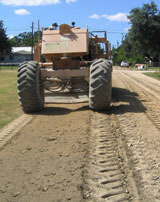
Pulverizing pavement
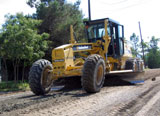
Shaping roadway
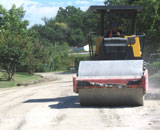
Compacting roadway
Recycling with cement is a process that most contractors are equipped to perform. “It’s easy to get contractors to install, it’s easy to inspect, and once you get your gradation, it’s easy to control,” LaHue said. “Quality control is not a big issue because the mixing process and the cement just work so well.”
Stephenville street superintendent Tony Gonzales agrees. “It’s a simple process,” said the 17-year veteran of the city’s street department. The process has “saved us a lot of money that we can use to do curb and gutter work,” he added.
Low-maintenance cement-recycled streets allow Stephenville officials to focus their time and money on other maintenance issues. Wells said, "We are beginning to see relief in our maintenance budget because our maintenance calls are a lot less. The maintenance on streets has been reduced and this frees us up to do other maintenance functions.”
Unlike other road construction processes, the cost of cement recycling has not risen dramatically over the years. City of Stephenville bid tabulations from 1992 show that contractors charged $2.60 per square yard (sq. yd.) for cement recycling. In 2003, the price rose only .80 to $3.40 per sq. yd., according to records provided by LaHue.
The confidence LaHue and city officials have in the process became evident when the city was faced with maintaining a major thoroughfare. In 1994, Texas Department of Transportation released its obligations for maintaining Harbin Street, a major high volume collector road running through Stephenville. LaHue decided to lower the pulverization depth to 8 inches and add 32 pounds per square yard of cement. A 2-inch asphalt surface capped the new road. Since its completion in 1995, the highly trafficked street has experienced “no base failures,” said LaHue. “It handles the traffic loads very well.”
Cement recycling’s speed of construction is also a big plus, said Gonzales. Crews begin the process early in the morning and finish recycling before residents come home from work. “We never close the streets,” said Gonzales. “I’ve become a big believer in cement.”
Compared to traditional remove and replace construction, “the inconvenience to residents is a lot less” says Rick Brockington, president, Brock Paving Industries, Roanoke. Brock Paving started up as a cement recycling contractor in 1990 and won a 2004 contract to rehabilitate Stephenville’s streets. "Cement recycling is a lot faster than complete reconstruction,” Brockington said. “It’s one-step stabilization.”
Brockington said cement recycling gives cities on tight budgets “more bang for the buck.”
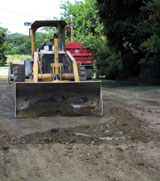 Cement recycling produces little leftover material. Usually 5 percent of the total roadway materials, if any, need hauled away.
Cement recycling produces little leftover material. Usually 5 percent of the total roadway materials, if any, need hauled away.
The decision to recycle has not gone un-noted by Stephenville residents. “Folks have been pretty appreciative that we’re being proactive rather than reactive,” Wells said.
For more information visit the Cement Council of Texas at www.RecyclingRoads.org